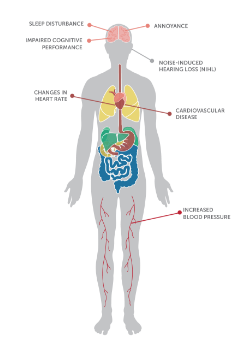Top 5 Takeaways from the Acoustics #WELLography
by Ethan Bourdeau

Have you ever wondered how the diverse soundscape you experience in your day to day can impact your health and productivity? This month, we released our Acoustics WELLography, which provides you with a comprehensive overview of sound and the built environment, how we experience and are impacted by sound, and strategies that can be applied to mitigate the negative risks associated with noise and other distracting sounds.
1. The human ear has a specific range of sensitivity across sound pressure level and frequency.
For example, the human ear is generally limited to the perception of sound pressure levels from 0 dB to 130 dB. The lower end of this range is on average closer to 10 dB with an upper limit at 130 dB, which is considered the threshold of pain. However, these limits can be subjective and depend more on an individual’s sensitivity. Human perception of sound frequency, otherwise known as “pitch”, ranges from approximately 20 to 20,000 Hz, with heightened perception within the frequency range of human voice between 1,000 Hz and 6,000 Hz. One example of frequency spectrum perception in the built environment is through HVAC equipment which can produce sound levels at low frequencies (e.g., rumbles, vibrations) and higher frequencies (e.g., duct hiss, diffuser/duct rattle).
Sensitivity of The Human Ear Across Sound Pressure Level and Frequency.1
2. Distracting sound can affect our bodies in more ways than we may realize.
While you’re reading this, there’s a great chance that some outside noise or nearby conversation could easily become distracting enough to take your eyes away and draw your focus elsewhere. While this in and of itself could cause annoyance and loss of focus, unwanted exposure to sound can also have less obvious impacts on the human body. For example, exposure to both internally and externally generated noise at levels as low as 55 dBA has been associated with an increase in urinary stress hormone excretion.2
Summary Of Possible Clinical Manifestations Of Noise Exposure.3
3. Sometimes adding sound to a space can increase comfort.
The idea of introducing sound to a space to improve comfort may sound counterintuitive, but it is a technique used throughout the industry. Sound masking is most commonly found in office environments as a way of masking speech frequencies and creating a sense of privacy in an open forum. However, sound masking has recently become a feature used in residential and healthcare settings. It has even been proven that sound masking can improve the quality of sleep for ICU patients, producing an overall improvement of 42.7%.4
4. Cities are loud…like, really loud!
It can be tough to live in a city, where it feels like the noise never stops and something is always causing a racket. Multiple studies correlate the effects of outdoor noise exposure to the overall health of building occupants and as a result, many municipalities and governments have introduced noise restrictions to create quieter communities. For instance, the U.S. Department of Housing and Urban Development (HUD) requires a 24-hour, day-night average sound level of less than 65 dB at a given building site. Special requirements and approvals even exist if the level is greater than 65 dB and even more if the level is greater than 75 dB.5
5. There is simply too much noise. How can I stop it?
Simple: obstruct the path of sound! There are a number of design optimizations, criteria, and construction techniques that projects and tenants can utilize to reduce the effects of indoor and outdoor noise sources. Here are just a couple examples: Windows can be provided with external, secondary glazing to provide additional mass and reduce airborne transmission of sound from outdoor sources. Demising partitions can be constructed with additional mass and airspace to better insulate room-to-room sound transmission. Mechanical equipment can be vibration isolated to reduce noise and rumble that can be felt and heard.
To learn more about how sound impacts health and strategies for designing spaces that can help optimize the soundscape for health and productivity download, our new WELL app, Build WELL.
Ethan is an Associate on the Standard Development team and the resident Acoustics expert at IWBI. Ethan’s contributions to IWBI draw from his experience in acoustical consulting and theater design in NYC. This Fall, you can find Ethan spinning laps around Central Park with Good Guys racing team.
Sources:
1. University of WisconsinHearing and Balance. neurophys.wisc.edu. [Online] n.d. [Cited: November 9, 2015. http://www.neurophys.wisc.edu/h&b/textbook/textindex.html.
2. Stress and open-office noise.Evans, GW and Johnson, D. 5, October 2000, Journal of Applied Psychology, Vol. 85, pp. 779-783. http://www.ncbi.nlm.nih.gov/pubmed/11055149.
3. Environmental Protection Agency.Noise Effects Handbook: A Desk Reference to Health and Welfare Effects of Noise.Fort Walton Beach : National Association of Noise Control Officials, 1981
4. Sleep disruption due to hospital noises: a prospective evaluation. Buxton, OM, et al. 3, August 07, 2012, Annals of Internal Medicine , Vol. 157, pp. 170-190. http://www.ncbi.nlm.nih.gov/pubmed/22868834.
5. U.S. Department of Housing and Urban Development. Sound Transmission Class Guidance. portal.hud.gov. [Online] n.d. [Cited: February 6, 2015.] https://portal.hud.gov/hudportal/documents/huddoc?id=DOC_16419.pdf.

